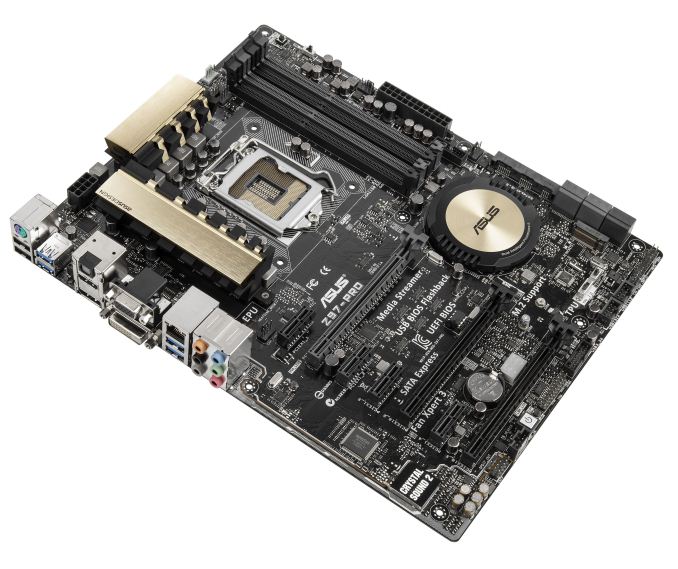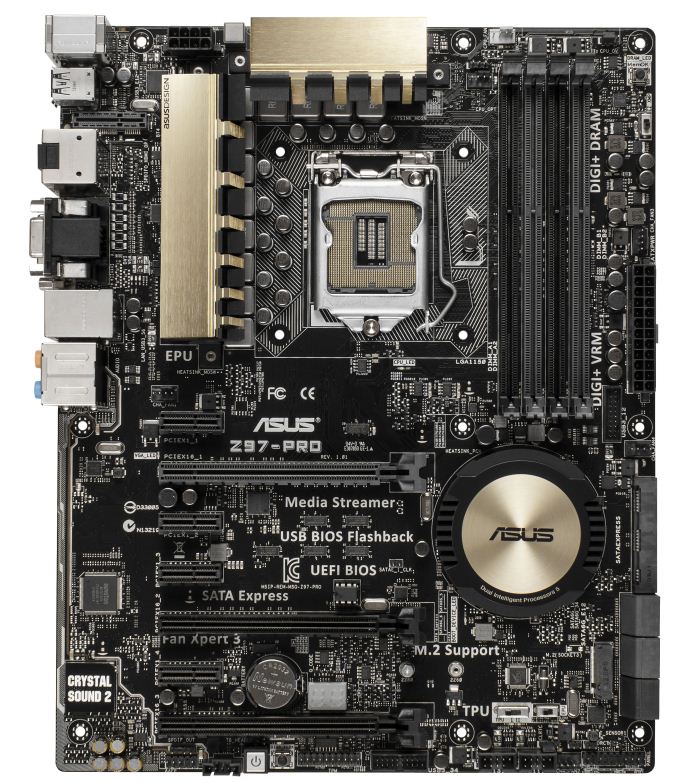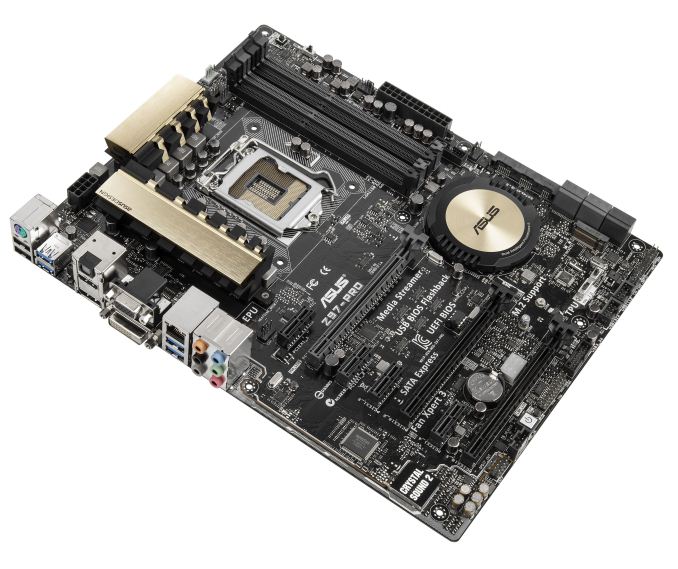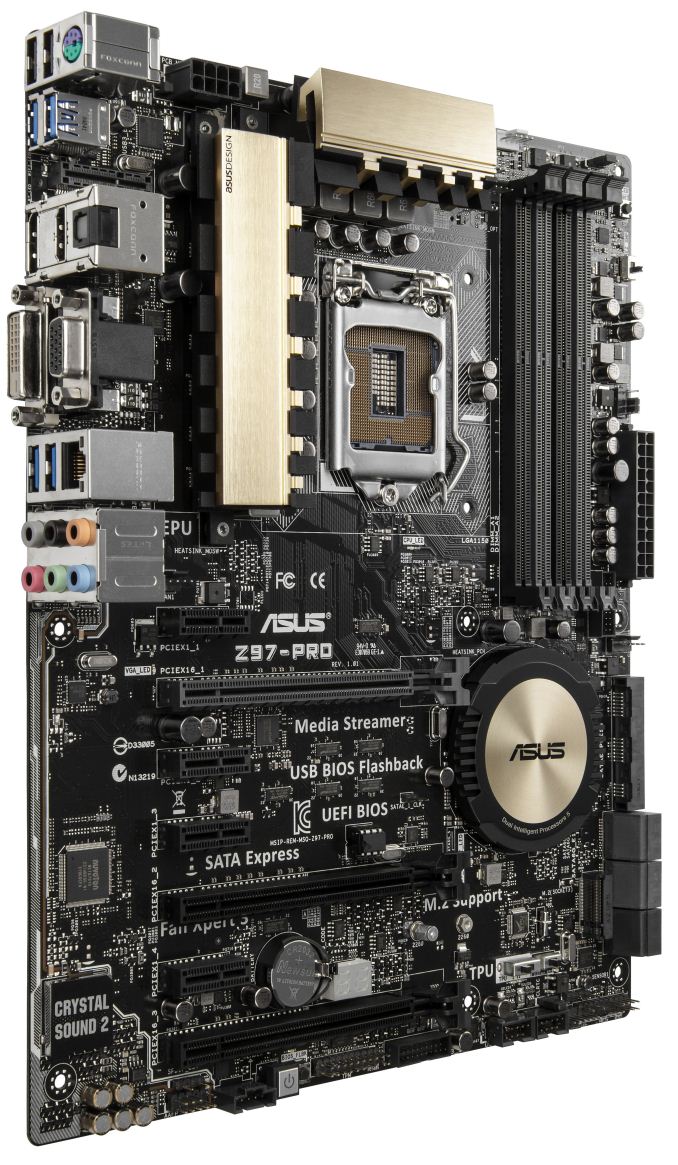ASUS Z97-Pro WiFi AC Review
by Ian Cutress on July 16, 2014 10:00 AM EST- Posted in
- Motherboards
- Asus
- Haswell
- 802.11ac
- Z97

The initial set of Z97 reviews demonstrated that most motherboard manufacturers were implementing at least one the new storage options offered by the chipset: SATA Express and M.2. The motherboard we are testing today, the Z97-Pro, uses both but incorporates a switching system so only one is active at the time. Similarly to the Z97-Deluxe which we have reviewed, ASUS’ new brushed metalling gold design is here on the Z97-Pro as well.
ASUS Z97-Pro WiFi AC Overview
The birth of SATAe and M.2 in the market is a strangely complicated one. Both of these new standards, despite the lack of drives for end-users to purchase, require two of the eight lanes from the chipset in order to function, as well as two SATA 6 Gbps ports for SATA modes. One would suggest that this requires four PCIe lanes in order to incorporate both onto a product; however the current solutions we have seen show that the lane allocation is shared by both M.2 and SATAe, meaning that using one disables the other. Sharing lanes is nothing new for motherboards, where we might see a PCIe 2.0 x4 slot share lanes with controllers or PCIe 2.0 x1 slots. Compounding this fact, Intel only officially supports their storage technology on a single x2 at a time and not both, suggesting that the switch method is the only appropriate way to evolve the situation. This leaves motherboards that use both of these technologies, when the products come to market, in a precarious position. The Z97-Pro takes the brunt of this head-on, as it were. While it is impossible to implement RST on two PCIe storage ports at once, a manufacturer can use an ASMedia controller for a SATAe port, which also consumes PCIe lanes and adds cost.
The Z97-Pro aims to tackle the large landscape of motherboard offerings around the $188 region, or $200 with added 802.11ac for the WIFI AC variant. This price bracket features others such as the Z97X-SOC, Fatal1ty Z97 and Z97 Gaming 7, all of which are aimed to sell with their respective crowds.
We examined the software and BIOS offerings of the ASUS Z97 range with the Z97-Deluxe which show a continued improvement over ASUS’ generational cadence, although the BIOS aesthetic recommendations still stand. Fan controls allow every fan header on board to be controlled through DC or PWM, and the built-in BIOS fan testing system helps expedite accurate fan profiles. The EZ OC mode in the BIOS also gives users a more targeted look at automatic overclocks. The software has a new trick in Turbo App, giving users overclock granularity on a per-program basis, as well as new overclocking options for stress testing.
Performance of the Z97-Pro shines out via the onboard audio (an enhanced Realtek ALC1150 solution with PCB separation, filter caps and DTS support) and Z97's excellent DPC Latency, however our early pre-release BIOS had a long POST time, suggesting that users should update the BIOS ASAP in case this has changed. Power consumption was a little higher than expected, but still in reasonable limits. USB 2.0 speed was boosted by the in-built Turbo mode, giving a sub 40-second result.
The Z97-Pro offers a WiFi version using a 2T2R 802.11ac WiFi module, situated on the rear IO. I am a big fan of integrated WiFi solutions on the rear IO rather, but the original increase in price for the version with the module was $30 might seem a little high. However, now the difference is $12 and given that the WiFi module is unavailable as a separate purchase, users with WiFi needs (such as myself who tests machines in a different room with no wired Ethernet access) should consider the WiFi version because even at $200 the system seems to punch above its weight. Normally when I review a system I keep a list of oddities, issues, irregularities or interesting tidbits of information as I test in order to help shape the review. With the Z97-Pro, my list contained a total of zero entries, indicating that it just worked as it said it should. This is sometimes an oddly rare occurrence in a mature industry.
ASUS Z97-Pro Visual Inspection
The brushed metallic look we saw with the Z97-Deluxe is here on the Z97-Pro as well, as shown on the two power delivery heatsinks and the new styled circular chipset heatsink. I hate to use artsy words to describe a motherboard, but I feel like I want to use the word ‘contemporary’, whatever that means. The ASUSDESIGN logo adorns one of the heatsinks, and the rest of the motherboard attempts to use two shades of black for the rest of the ports and slots. The switches and rear IO keep their silvery look.
The socket area is bounded on two sides of the minimum Intel specifications by power delivery chokes and on a third side by the DRAM slots. As with most motherboards in this segment, the heatsinks are designed to allow large coolers, however due to the close proximity of the DRAM slots, users with taller memory might have to rely on slightly smaller CPU coolers in order to fit a full set of memory.
In the socket area the user has access to four fan headers: one to the bottom left below the power delivery heatsink, the two CPU headers between the top heatsink and the DRAM, and a final header just above the 24-pin ATX power connector. At a stretch there is a fifth within reach of the socket, just below the 24-pin, while the sixth and final fan header is at the bottom of the motherboard.
The DRAM slots are color coordinated for the two memory channels, and all four slots use a single sided latch mechanism for easier memory removal. With this system users should be aware that installing memory requires a double check to make sure it is seated in the slot correctly.
At the top right of the motherboard is the MemOK button, used to recover memory settings from a failed overclock without losing the rest of the BIOS settings in the process. Below this is the EZ XMP switch, a new addition for Z97 that allows users to enable XMP at the touch of a button and without entering BIOS. Given the number of enthusiast users, especially (anecdotally) at LAN events, who have super machines but fail to run at XMP, this is a nice option to have.
The SATA ports are arranged such that the SATA Express port is nearest the 24-pin ATX, followed by four chipset SATA 6 Gbps ports and two SATA 6 Gbps from the ASMedia controller. Given what we have seen from GIGABYTE and ASRock, I am a little perplexed as to why ASUS did not invest into the tiered/stacked SATA plastic housing and routed appropriately, as this would have saved some space for (perhaps) another SATA controller or something else (a USB port?). Beside the chipset SATA 6 Gbps ports is the M.2 x2 slot, which as mentioned above shares bandwidth with the SATAe ports such that only one can be used at a time.
Along the bottom of the motherboard we have the T_Sensor that allows users to equip their own thermocouple and adjust the fan speeds on the motherboard based on the output of the thermocouple. Next to this is the DirectKey header that allows the user to enter the BIOS on the next boot. This feature used to be an onboard button, which I prefer, but has been relegated to jumper duty. Above these two jumpers are the TPU and EPU switches, providing automatic overclocks and power saving modes respectively. Beneath these, right at the bottom of the board, is the front panel header, one of the aforementioned fan headers and two USB headers.
Moving left across the bottom of the motherboard we have our second chipset based USB 3.0 header, a TPM module header, the BIOS Flashback button, a power button, the Thunderbolt header and the front audio header. Above the TPM header, and just above the PCIe slot in this place, is the two-digit Debug display. This position between the PCIe slots is a little different to what we usually encounter, and in this position it would be blocked by a second GPU.
The PCIe slots are arranged in a typical fashion, with an x1 at the top followed by x16, x1, x1, x8, x1 and an x4. When a device is placed in the x8 slot, the x16 will reduce down to x8 to compensate. The two PCIe 2.0 x1 slots in the middle actually share bandwidth, with the bottom of the two enabled by default. The PCIe 2.0 x4 actually shares bandwidth with two other parts of the motherboard – the two chipset USB 3.0 ports on the rear IO, and the final PCIe 2.0 x1 slot. By default the PCIe 2.0 x4 slot is in x1 mode, and the USB 3.0 ports/PCIe x1_4 slot are both enabled. In x2 mode, the PCIe x1_4 slot is disabled, and in x4 mode both the PCIe x1_4 and USB3_E12 are disabled.
The audio on the Z97-Pro is an enhanced version of the Realtek ALC1150 audio codec featuring PCB separation, separate PCB layers for left/right signaling, an EM shield, additional filter caps, a headphone amplifier, DTS support and a de-pop circuit.
The rear IO of the motherboard gives a combination PS/2 port, two USB 2.0 ports, four USB 3.0 ports, the four standard video outputs, gigabit Ethernet (Intel I218-V) and audio jacks. Normally I prefer more than two USB 2.0 ports for installing an operating system via USB (ideally need three in case USB 3.0 are not initialized), however there was no issue here. One might argue that having all four video outputs on the rear is redundant given the targeted use of this motherboard is towards PCIe users, and some part of me is wondering if dual HDMI+DisplayPort or dual mDP + HDMI/DVI-D is more a preferred option going forward. The gap in the rear IO shown above is where the WiFi Go module should sit.
Board Features
| ASUS Z97-Pro (WiFi AC) | |
| Price | US (Newegg) |
| Size | ATX |
| CPU Interface | LGA-1150 |
| Chipset | Intel Z97 |
| Memory Slots |
Four DDR3 DIMM slots supporting up to 32 GB Up to Dual Channel, 1333-3200 MHz |
| Video Outputs |
VGA (1920x1200 at 60 Hz) DVI-D (1920x1200 at 60Hz) HDMI (4096x2160 at 24 Hz or 2560x1600 at 60 Hz) DisplayPort (4096x2160 at 24 Hz or 3840x2160 at 60 Hz) |
| Onboard LAN |
Intel I218-V Broadcom 802.11ac 2T2R |
| Onboard Audio | Realtek ALC1150 (DTS) |
| Expansion Slots |
2 x PCIe 3.0 x16 (x16 or x8/x8) 1 x PCIe 2.0 x4 (Shares bandwidth with USB3_E12 and PCIe x1_4) 4 x PCIe 2.0 x1 (PCIe x1_2 shares bandwidth with PCIe x1_3) |
| Onboard SATA/RAID |
6 x SATA 6 Gbps (PCH) (two shared with SATAe) 2 x SATA 6 Gbps (ASMedia) 1 x SATAe x2 (PCH) (shared x2 and SATA with M.2) 1 x M.2 x2 (PCH, SATA and PCIe) (shared x2 and SATA with SATAe) |
| USB 3.0 |
6 x USB 3.0 (PCH) (2 back panel, 2 headers) 2 x USB 3.0 (ASMedia) (2 back panel) |
| Onboard |
8 x SATA 6 Gbps 1 x SATAe 1 x M.2 2 x USB 3.0 Headers 2 x USB 2.0 Headers 1 x TPM Header 6 x Fan Headers 1 x TB Header EZ XMP Switch DirectKey Button MemOK Button TPU Switch EPU Switch USB BIOS Flashback Button Front Panel Header Front Audio Header Two Digit Debug Power Button |
| Power Connectors |
1 x 24-pin ATX 1 x 8-pin CPU |
| Fan Headers |
1 x CPU (4-pin, DC+PWM) 1 x CPU_OPT (4-pin, DC+PWM) 4 x CHA (4-pin, DC+PWM) |
| IO Panel |
1 x PS/2 Combination Port VGA DVI-D HDMI DisplayPort 1 x Intel I218-V NIC 4 x USB 3.0 2 x USB 2.0 WiFi Go! Module Audio Jacks |
| Warranty Period | 3 Years |
| Product Page | Link |














38 Comments
View All Comments
DanNeely - Wednesday, July 16, 2014 - link
Where're you finding it for <$200? Newegg has it at $219. The shopping search in the where to buy link picks up several lower spec models in the same family.owan - Wednesday, July 16, 2014 - link
Reading all these z97 reviews only underscores how badly intel needs to increase the number of available PCIe lanes, particularly the 3.0 lanes off the CPUGigaplex - Wednesday, July 16, 2014 - link
That's why Intel has the enthusiast socket 2011 platform.DanNeely - Friday, July 18, 2014 - link
Unfortunately Intel's kept it crippled by delaying the enthusiast CPUs using it until they complete all the extra testing/validation they claim is needed for Xeons but not regular consumer parts. If they'd release the enthusiast parts at about the same time as the mass market ones and then the Xeon's a year later it'd get much more respect. As it stands, it's basically just smoke and mirrors.rchris - Wednesday, July 16, 2014 - link
Appreciate the fine review. However, I really wish product reviews would include some data or sampling of the manufacturer's customer service performance. I know there are feedback comments on sites such as Newegg.com, but they are all horror stories and it's hard to tell if they represent what typically happens when you get a lemon and have to deal with it.ggathagan - Wednesday, July 16, 2014 - link
What would be better would be an investigative article that dealt solely with the quality of customer service from all the manufacturers over a period of, say 2-3 months.There are only a handful of motherboard providers. To add this to every review would be needlessly redundant.
Customer service tends to be quite hit-or-miss, since so much of it depends on the individual who takes your call.
Farwalker2u - Wednesday, July 16, 2014 - link
Hysteresis, the dependence of the output of a system not only on its current input, but also on its history of past inputs.I had to look it up.
I never knew there was such a system. Your suggestion for additional fan settings with this as part of the mix makes sense.
demonqueller - Friday, July 18, 2014 - link
No Firewire ports on this board either. Since they were lacking on Asrock's and MSI's offerings, does this mean Firewire is dead? Those of us with external Firewire audio interfaces have to rely once again on third-party add-on cards. Not a huge deal, but the extra cost (and crowding on the board) is annoying.DanNeely - Friday, July 18, 2014 - link
Yeah, it's more or less dead. At this point it's not even so much the $5-10 that adding the controller/port increases the retail cost. It's that the controller eats a PCIe lane and Intel doesn't give us enough of them; virtually every mid/high end ATX motherboard is either having lane allocation switched around in software or using a PLX as a port multiplier to add more lanes. FW lingered as long as it did because as long as you had a PCI controller (either in the chipset or a PCIe-PCI bridge chip) you could hang several devices off it for the cost of routing traces to them.The rumor is that Intel will be increasing CPU PCIe lanes on Skylake from 16 to 20; but with that ostentatiously being about PCIe based storage; they really need to offer an enthusiast chipset with 12 or 16 lanes instead of 8 too.
demonqueller - Friday, July 18, 2014 - link
Yes, more lanes would be nice. ... I'm building a new rig using the 4790K chip to replace my ancient CoreDuo 8400. I haven't settled on a board yet; I'm wavering between this ASUS or ASrock's Extreme 6. The computer primarily will be used for music recording / mixing, but I also do 3D work. Anyway, my old rig, with a max of 8GB RAM struggled. I hope that won't be an issue anymore with 32GB, even if I'm using a PCI card to support my Firewire ports.